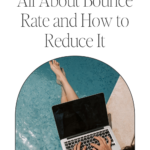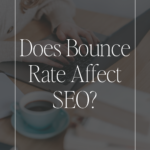
All About Bounce Rate and How to Reduce It
Table of Contents
ToggleSharing is caring!
Reading Time: 4 minutes


How long do readers stay on a website? Users will only stay an average of 10 to 15 seconds on a website. They'll quickly move on to other blog sites or websites if they do not find what they are looking for. That’s because the average readers have an attention span of 8 seconds.
If you've been measuring the metrics (like you should, always!) and seeing many readers leaving your website, it means your site has a high bounce rate.
What is a bounce rate, and what does it mean when you have a high one? How can you reduce the number of people leaving your website and get them to stay longer? We'll answer all these questions in this guide.

What is a Bounce Rate?
Bounce rate is a metric that measures the number of single-page sessions on a website. It tells you how many visitors leave a website after viewing only one page. In the context of a blog site, a site with a high number of people leaving after viewing only a page has a high bounce rate.
A high bounce rate means readers are not engaging with your content and are leaving within seconds of arriving on your blog site. Most websites have an average bounce rate of 70% to 80%.
While it's perfectly normal for people to leave a site and look for infos elsewhere, a higher-than-average bounce rate is a sign that your content is not connecting with the right people. If you don't do something about the high bounce rate, you're not marketing to the right audience.
Does Bounce Rate Affect SEO?
The quick answer is no; bounce rates do not affect SEO because search engines do not use bounce rates as a factor in rating websites' page rankings. However, it can affect user engagement, an essential element of SEO.
Think of bounce rates as an indicator of an issue with your content. It reflects the engagement level of visitors. While bounce rates don't affect your overall page rankings, they affect how readers interact with your website. And poor interactions lead to poor outcomes.
There are many reasons why a website has a high bounce rate, some of which include the following:
- Poor navigation
- Poor user experience
- Slow loading times
- Web pages are not mobile-friendly
- Outdated content
- Irrelevant content
- Complex content
Any of the factors above do affect your website's page rankings. According to Yoast, a website with a higher than usual bounce rates are likely to have:
- Low-quality content
- The content is not inviting
- The purpose of the page does not match the audience
- Visitors cannot find what they are looking for
To find out why people are looking elsewhere for content rather than staying on your website, you must analyse the pages and blog posts with higher-than-average bounce rates, find out what's causing the issue and address it right away.
What's a Good Bounce Rate for Blog Posts?
Content sites like blog sites have a lower bounce rate than e-commerce and service sites. However, blog posts have higher bounce rates than other website pages.
Depending on the industry, content sites should have an average bounce rate between 40% to 60%, according to Clicktale. eCommerce sites should have 33% bounce rates, while service sites should have 10% to 30% bounce rate.
But even if your bounce rate is close to 80%, it doesn't necessarily mean your website is not connecting to your target audience. It just means you need to optimise your content to engage your audience.
How to Increase Engagement and Reduce Bounce Rate
Now that you know what factors affect a website's bounce rate, here are some tips that'll help you improve your website's performance.
Mind the viewer intent
One of the most important factors to consider when analysing a site for its bounce rate is to consider viewers' intent when finding your blog posts in the searches. Some viewers want to make an immediate purchase; others look for helpful resources before making a decision. Others are still undecided and need a little push before making a purchase. All these situations will affect a blog site's bounce rate. You must have blog posts that fall into these categories to attract a broader audience.
Focus on relevance
People go online to seek answers to questions. They want problems to solve, and if they cannot find the answer to their questions on your website, they will take their business elsewhere. Your topics should be relevant to your target audience to avoid a high bounce rate.
Keep away from subjects that have nothing to do with your core topic, even if the said topics are going viral. If a topic is not part of your industry in any way, don't blog about it. A cohesive content strategy and consistent, on-brand content will benefit your website in the long term.
Work on the load speeds
Your website should only take 3 seconds to load; otherwise, viewers will go to a different site to find what they are looking for. Loading times are so important that Google and major search engines use them as benchmarks for search rankings. To speed up the loading times, avoid a clustered website structure.
Website builders like Showit offer tastefully designed websites that load quickly. Whenever you upload a video or any visual content, compress them first. For the tech-savvy, try removing unused codes and implementing the minification of HTML, CSS, and Javascript.
Offer diverse content
A sidebar that outlines popular, related, or recent content can reduce bounce rates because these helpful resources will encourage viewers to stick around and explore your website. You'll get good results by suggesting articles on a blog post, but having a dedicated section on your website for related content is best. This goes especially if you are using cluster blog posts.
Build internal links
If you think link building is outdated, think again. It remains one of the most essential SEO strategies because it works! Link building triggers search engine bots to analyse your site's informational hierarchy, affecting overall SEO and bounce rate. Internal links give readers more topics related to the primary topic, and these encourage readers to click more links before the end of the article.
A website's bounce rate is an important metric for monitoring user engagement levels of visitors. Start by simplifying the structure of your website, accelerating loading speeds, and providing relevant content that readers would find helpful.
Most Popular Posts:
Sharing is caring!
PLEASE COMMENT BELOW